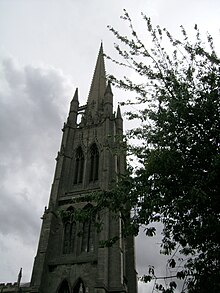St James' Church, Louth
| St James' Church, Louth | |
|---|---|

The church belfry and spire
|
|
| 53°22′00″N 0°00′29″W / 53.3666°N 0.0080°WCoordinates: 53°22′00″N 0°00′29″W / 53.3666°N 0.0080°W | |
| Denomination | Church of England |
| Churchmanship | Broad Church |
| Website | www.stjameschurchlouth.com |
| History | |
| Dedication | James, son of Zebedee |
| Administration | |
| Parish | Louth, Lincolnshire |
| Diocese | Lincoln |
| Province | Canterbury |
| Clergy | |
| Rector | Nicholas Brown |
| Laity | |
| Organist/Director of music | Lisa Taylor |
St. James' Church, Louth is a parish church in the Church of England in Louth, Lincolnshire, England. It is notable for its tall spire.
The church is a medieval building. It has the tallest steeple of any medieval parish church in Britain. A recent survey has confirmed the height of the stonework as 287 feet and 6 inches (87.63 metres) and to the top of the cockerel weather vane as 293 feet 1 inch (89.3 metres). It also confirms it as one of the very finest medieval steeples in the country
The chancel and nave were re-built between 1430 and 1440. The building of the tower probably commenced in the 1440s or 1450s and had been completed to its present height by 1499. Work began on the spire in 1501 and it was not finished until 1515. The weathercock was placed on the top of the spire amongst great rejoicing on the eve of Holy Cross day Thursday 13 September 1515. This 'wedercoke' had been made in Lincoln from a huge copper basin captured from the Scots at the Battle of Flodden in 1513 and subsequently bought in York by Thomas Tayleyor one of the churchwardens. The total cost of the spire alone was £305 8s 4d, a large amount of money for the time. The spire was restored in 1844 by Lewis Nockalls Cottingham. A further restoration took place between 1861 and 1869 by James Fowler, known as 'Fowler of Louth'.
The church is mainly 15th century and is the third building on the site, replacing 11th- and 13th-century buildings.
Originally the church had five subsidiary chapels and altars and a three-storey rood screen.
In October 1536, as a result of Henry VIII's ecclesiastical changes, people gathered in the church to start the Lincolnshire Rising, which was followed by the Pilgrimage of Grace. Neither succeeded and the church was stripped of its riches including the rood screen.
In 1937, it flew the highest flag in Lincolnshire to mark the coronation of George VI. Later that year, renovation work commenced on the spire, under the supervision of the architect, Mr. Goddard, who had previously worked on Lincoln Cathedral.
...
Wikipedia
